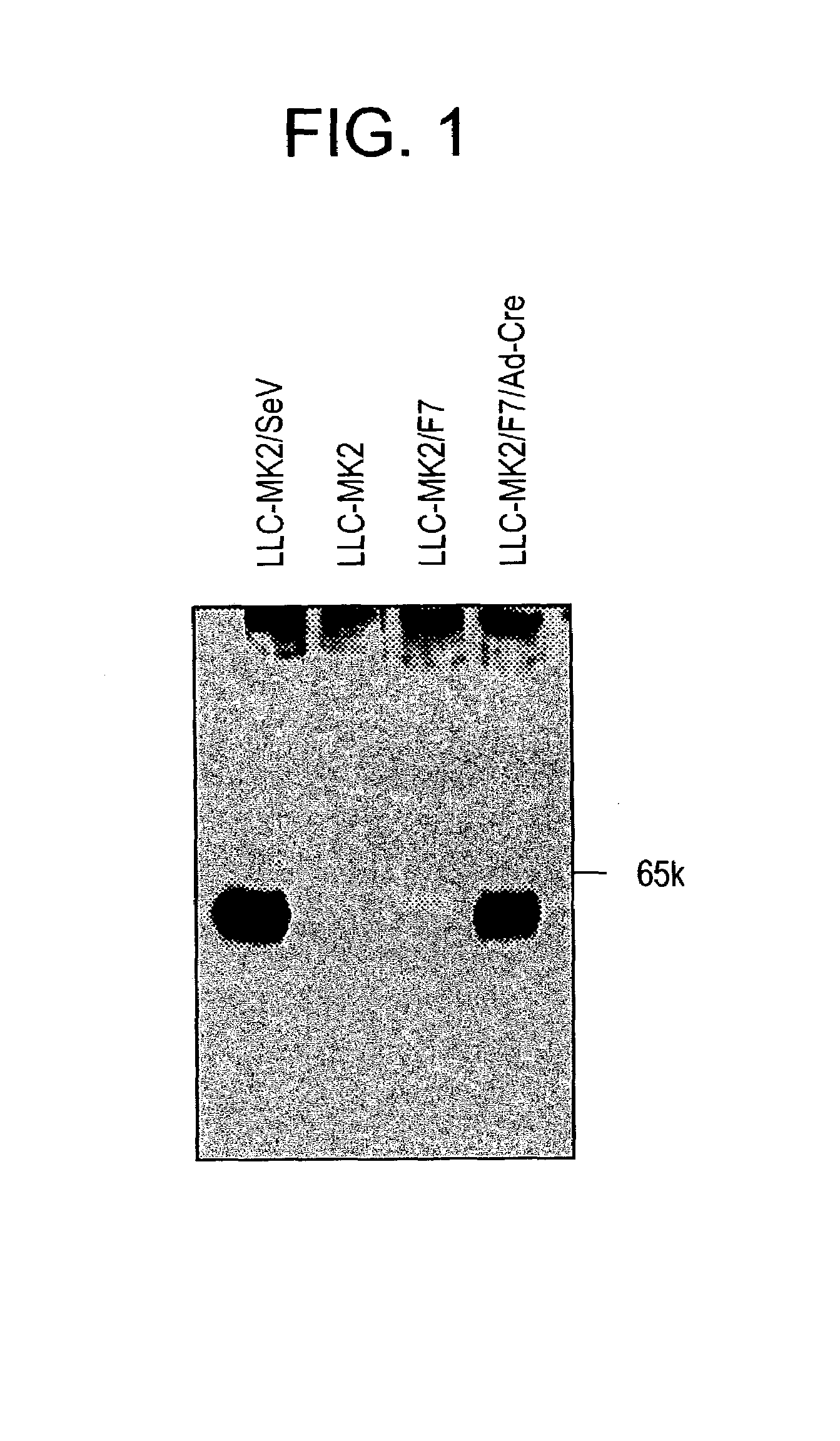Envelope gene-deficient Paramyxovirus vector
- Summary
- Abstract
- Description
- Claims
- Application Information
AI Technical Summary
Benefits of technology
Problems solved by technology
Method used
Image
Examples
example 1
Construction of F-Deficient Sendai Virus
Construction of F-deficient SeV Genomic cDNA and F-expressing Plasmid
[0199]The full-length genomic cDNA of Sendai virus (SeV), pSeV18+ b(+) (Hasan, M. K. et al., 1997, J. General Virology 78: 2813–2820) (“pSeV18+ b(+)” is also referred to as “pSeV18+”) was digested with SphI / KpnI, and the resulting fragment (14673 bp) was recovered and cloned into plasmid pUC18 to generate pUC18 / KS. The F-disrupted site was constructed on this pUC18 / KS. The F gene disruption was performed by the combined use of PCR-ligation method, and as a result, the ORF for the F gene (ATG-TGA=1698 bp) was removed; thus atgcatgccggcagatga (SEQ ID NO: 1) was ligated to it to construct the F-deficient SeV genomic cDNA (pSeV18+ / ΔF). In PCR, a PCR product generated by using a primer pair (forward: 5′-gttgagtactgcaagagc / SEQ ID NO: 2, reverse: 5′-tttgccggcatgcatgtttcccaaggggagagttttgcaacc / SEQ ID NO: 3) was ligated upstream of F and another PCR product generated by using a primer...
example 2
Confirmation of Function of SeV-F Protein Expressed by Helper Cells
[0210]It was tested whether or not SeV-F protein, of which expression was induced by helper cells, retained the original protein function.
[0211]After plating on a 6-cm dish and grown to be confluent, LLC-MK2 / F7 cells were infected with adenovirus AxCANCre at moi=3 according to the method of Saito et al. (described above). Then, the cells were cultured in MEM (serum free) containing trypsin (7.5 μg / ml; GIBCO-BRL) at 37° C. under 5% CO2 in an incubator for three days.
[0212]The culture supernatant was discarded and the cells were washed twice with PBS buffer, scraped off with a scraper, and collected by centrifugation at 1500×g for five minutes. The cleavage of expressed F protein by trypsin was verified by Western blotting as described above (FIG. 3). SeV-F protein is synthesized as F0 that is a non-active protein precursor, and then the precursor is activated after being digested into two subunits F1 and F2 by proteol...
example 3
Functional RNP Having F-deficient Genome and Formation of Virions
[0213]To recover virions from the deficient viruses, it is necessary to use cells expressing the deficient protein. Thus, the recovery of the deficient viruses was attempted with cells expressing the deficient protein, but it was revealed that the expression of F protein by the helper cell line stopped rapidly due to the vaccinia viruses used in the reconstitution of F-deficient SeV (FIG. 5) and thus the virus reconstitution based on the direct supply of F protein from the helper cell line failed. It has been reported that replication capability of vaccinia virus is inactivated, but the activity of T7 expression is not impaired by the treatment of vaccinia virus with ultraviolet light of long wavelengths (long-wave UV) in the presence of added psoralen (PLWUV treatment) (Tsung et al., J Virol 70, 165–171, 1996). Thus, virus reconstitution was attempted by using PLWUV-treated vaccinia virus (PLWUV-VacT7). UV Stratalinke...
PUM
| Property | Measurement | Unit |
|---|---|---|
| Temperature | aaaaa | aaaaa |
| Volume | aaaaa | aaaaa |
| Volume | aaaaa | aaaaa |
Abstract
Description
Claims
Application Information
 Login to View More
Login to View More - R&D
- Intellectual Property
- Life Sciences
- Materials
- Tech Scout
- Unparalleled Data Quality
- Higher Quality Content
- 60% Fewer Hallucinations
Browse by: Latest US Patents, China's latest patents, Technical Efficacy Thesaurus, Application Domain, Technology Topic, Popular Technical Reports.
© 2025 PatSnap. All rights reserved.Legal|Privacy policy|Modern Slavery Act Transparency Statement|Sitemap|About US| Contact US: help@patsnap.com



